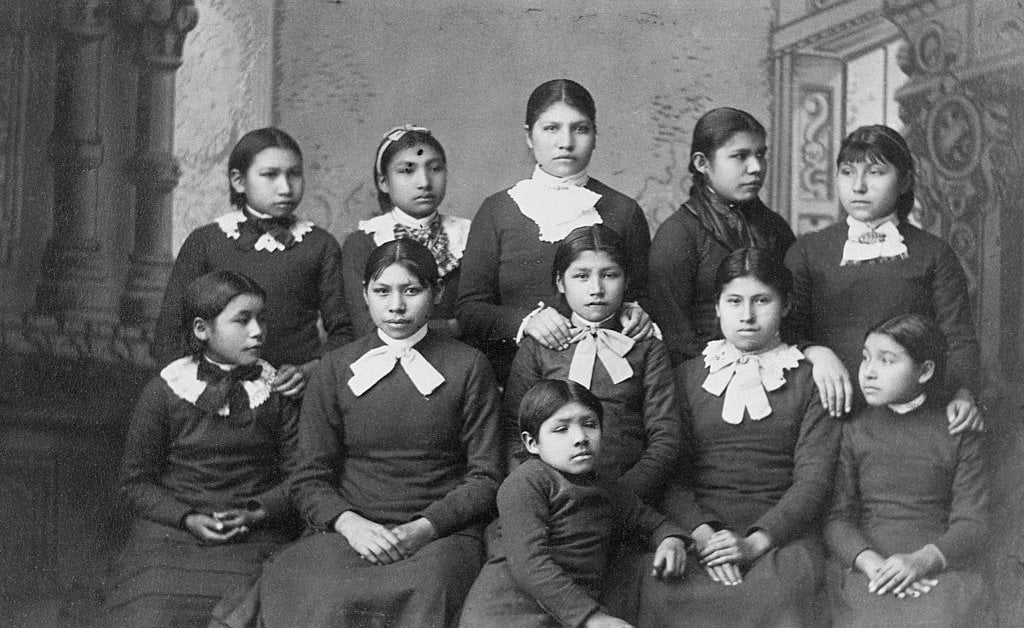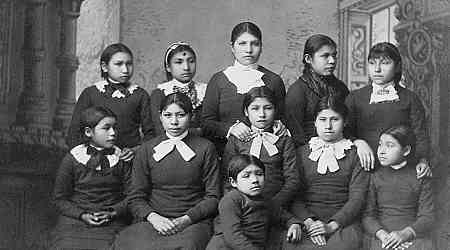
Each year during Native American Heritage Month in November, school classrooms around the country focus on Indigenous history. For educators in Illinois, this fall marks the first school year with a new state mandate to teach Native histories in elementary and high school classrooms, a shift that brings Illinois into alignment with at least 14 other states that require teaching Indigenous histories.
[time-brightcove not-tgx=”true”]Schools taking on the work of teaching Indigenous histories must understand how schools have historically been tools for violence, land theft, and assimilation against Native students and communities. The U.S. Department of the Interior recently released the second volume of its boarding school initiative report, which documents the history of 417 federal Indian boarding schools and over 1000 other similar institutions used to assimilate Native children between 1819 and 1969.
A reparative response to this history involves telling honest, difficult histories. And it also involves lifting up histories of Native people who, in the context of school violence, found ways to create or safeguard affirming spaces for all learners.
Read More: Biden to Apologize for 150-year Indian Boarding School Policy
Histories of school violence—and the equally long history of Indigenous resistance to it—stretch back more than 200 years in North America. In 1819, Congress passed the Civilization Fund Act to allocate federal funds to pay “persons of good moral character” (often missionaries) to teach Native communities European-style agriculture, western gender roles, and reading, math, and writing in English. Such approaches situated Indigenous languages and lifeways, including Indigenous place-based science developed over millennia, as inferior to settler cultures. As Lori Daggar demonstrates, federal officials used these “civilization funds” to train Native people as laborers who would work but, under settlers’ assumptions, not own the land.
From 1819 through the end of congressional treaty-making with Native nations in 1871, hundreds of treaties included a federal commitment to provide educational services to Native people. These commitments were part of nation-to-nation agreements for goods and services in exchange for access to Indigenous territories. Native negotiators who agreed to provisions about schooling in the treaties were likely anticipating that Native students would need preparation for future diplomatic and trade negotiations with the United States. Native negotiators brought with them expertise based on their nations’ diplomatic histories; and yet, the treaty talks they entered were profoundly unequal, marked by coercion, fraud, manipulation, and threats of physical violence.
By the late 1870s, the federal government shifted its tactics from primarily outsourcing teaching Native people to missionaries, to running its own schools. Beginning with Hampton and Carlisle, the federal government eventually staffed assimilative schools in at least 39 states. Federal agents often removed children from their families by force or through coercion, and, starting in 1893, Congress approved the withholding of food, clothing, and financial payments to families who kept their children out of school, a statute that remained in place until 2022.
The curriculums in these institutions attempted to force Native students to abandon their identities, participate in the dispossession of their communities’ homelands, and assimilate into American society as subservient laborers. The rampant physical, sexual, and mental abuses of students in federally administered schools has been well documented, and today, attempts to identify and return the bodies of over 900 children who died while in the schools are ongoing.
Starting in the late 1890s, the federal government began pushing Native students into public schools, in part to divest itself of the costs of running schools for Native youth. Doing so shifted some of the costs of educating Native students from the federal government to states and localities, which often pushed back, leading to a series of court cases in the 1920s and 1930s about the financial responsibility for serving Native students.
Although courts clarified that Native students are owed admission to public schools as any other child residing in a given state, schools were unprepared to serve Native students, leading to classrooms where Native students often experienced profound isolation and invisibility. This included being miscategorized as other races or ethnicities. When school materials referenced Native people, they reflected racist tropes about Indigenous violence, cultural inferiority, and imagined extinction, ideas developed under turn-of-the-century eugenicists and salvage anthropologists. Such isolation, invisibility, and mischaracterization created classroom environments where anti-Indigenous narratives flourished, going hand-in-hand with more tangible forms of bullying and discrimination. As generations before them in mission and boarding schools, Native students in majority-white public schools were expected to adopt white cultural norms, including false historical narratives about their own communities.
Native people have always creatively resisted the violence of assimilative schooling. For each historical period of U.S. Native school policy—missionaries, boarding schools, public schools—there are powerful examples of Native people who challenged harmful practices in education.
For example, Native students attending local public schools in Chicago at the turn of the century encountered stereotypical and racist depictions of Indigenous people in their textbooks and curricula. In response, in the 1920s, during a wave of Indigenous intellectual organizing, the Indian Council Fire (ICF) in Chicago called for better representation of Native people in school textbooks.
Despite the ICF’s lobbying, little changed for Native students in Chicago’s schools. Fifty years later, in 1971, the Chicago Tribune documented how Menominee mother and activist Carol Warrington was jailed after pulling her children out of school in protest of the inaccurate and harmful depictions of Native people in their school textbooks.
Beyond Chicago, curricular representations and educational funding for Native students remained a nationwide problem. In the 1970s, Red Power protests often addressed schools. During the Trail of Broken Treaties occupation of the Bureau of Indian Affairs building in 1972, author and activist John Trudell addressed the need to renegotiate federal education funding under the Johnson-O’Malley program. This activism helped shape the Indian Education Act of 1972, which constituted a major expansion of administrative and financial support for local, culturally affirming educational initiatives for Native students.
Read More: My Mythic American Inheritance
While the federal boarding schools offer the clearest historical example of violent assimilative curricula and school design, public schools remain sites of violence for Indigenous students.
The continued use of caricatures of Indigenous people as mascots since the early-mid 1900s, and the ongoing broad erasure of Indigenous histories and governments from curricula have made schools places where Native people have not been seen as contemporary, full people and nations. Such misrepresentations are not just harmful for Native students; they negatively impact all students in their inaccurate and limited representation of American history, contemporary life, and political structures.
Recognizing the importance of accurate, holistic historical content for all students, Native educators and parents of Native children have created school resources in nearly every state. As Priscilla Buffalohead, who authored multiple teachers’ guides in the 1980s, once shared with me, she became a curriculum writer “primarily because of my [Ponca] children. I wanted to write curriculum that showed the beauty and integrity” of Indigenous life, to combat discrimination, and to address “what was missing from the school curriculum.” More recently, the community-based Indigenous Chicago curriculum joins these efforts.

Stephanie Fryberg, a Tulalip psychologist, has described invisibility as the contemporary form of racism for Native people. A lack of understanding of Native people is not only detrimental for Native students; as a society, we rob all students of core information about American history, geography, culture, and law when Native people are left out of the curriculum.
This fall, as teachers across the country use Native American Heritage Month to teach and learn about Indigenous peoples, they have a role in directly combating that invisibility. When they do so in robust ways that center Indigenous perspectives and priorities, they can move us away from centuries of school-based violence and instead work to shape more just and affirming learning spaces for all students.
Meredith L. McCoy (Turtle Mountain Band of Ojibwe descent) is assistant professor of American Studies and History at Carleton College, and the author of On Our Own Terms: Indigenous Histories of School Funding and Policy (Nebraska University Press, 2024). She co-authored the recently released Indigenous Chicago curriculum for high school students.
Made by History takes readers beyond the headlines with articles written and edited by professional historians. Learn more about Made by History at TIME here. Opinions expressed do not necessarily reflect the views of TIME editors.




























